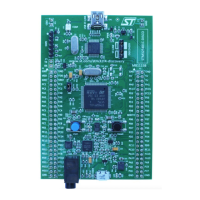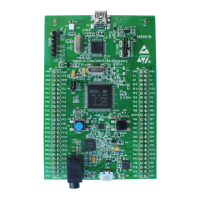RM0402 Rev 6 1127/1163
RM0402 Debug support (DBG)
1153
30.4.3 Internal pull-up and pull-down on JTAG pins
It is necessary to ensure that the JTAG input pins are not floating since they are directly
connected to flip-flops to control the debug mode features. Special care must be taken with
the SWCLK/TCK pin which is directly connected to the clock of some of these flip-flops.
To avoid any uncontrolled IO levels, the devices internal pull-ups and pull-downs on the
JTAG input pins:
• NJTRST: Internal pull-up
• JTDI: Internal pull-up
• JTMS/SWDIO: Internal pull-up
• TCK/SWCLK: Internal pull-down
Once a JTAG IO is released by the user software, the GPIO controller takes control again.
The reset states of the GPIO control registers put the I/Os in the equivalent state:
• NJTRST: AF input pull-up
• JTDI: AF input pull-up
• JTMS/SWDIO: AF input pull-up
• JTCK/SWCLK: AF input pull-down
• JTDO: AF output floating
The software can then use these I/Os as standard GPIOs.
Note: The JTAG IEEE standard recommends to add pull-ups on TDI, TMS and nTRST but there is
no special recommendation for TCK. However, for TCK, the devices needs an integrated
pull-down.
Having embedded pull-ups and pull-downs removes the need to add external resistors.

